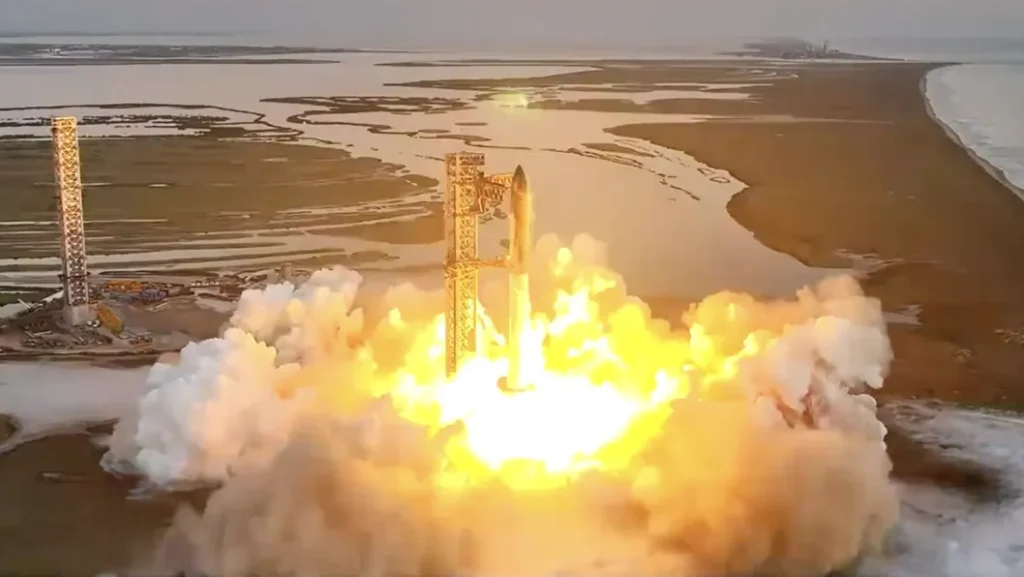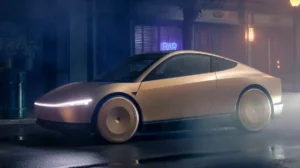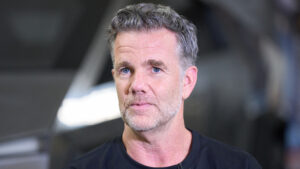SpaceX achieved a remarkable milestone on Sunday, October 13, by conducting what is arguably the boldest test flight of its Starship rocket. The flight concluded with the company catching the returning booster at the launch pad using a set of mechanical arms, a feat that has drawn widespread acclaim.
Elon Musk, the CEO and founder of SpaceX, celebrated the event, stating, “Science fiction without the fiction part.” This ambitious test saw the nearly 400-foot (121-meter) Starship lift off at sunrise from the southern tip of Texas, near the Mexican border. The rocket ascended gracefully over the Gulf of Mexico, reminiscent of previous Starship test flights that ended in destruction shortly after takeoff or during water landings. The last test, conducted in June, was deemed the most successful until this latest demonstration, as it completed its flight without an explosion.
Musk upped the ante for this test flight, which is part of his larger vision for using Starship to return humans to the moon and eventually send them to Mars. The first-stage booster returned to the launch pad seven minutes after liftoff, a maneuver that required precise coordination. At the command of the flight director, the booster flew back and was captured by the launch tower’s massive mechanical arms, nicknamed “chopsticks.” The arms successfully gripped the descending booster, suspending it above the ground.
“The tower has caught the rocket!!” Musk announced on X. “A big step towards making life multiplanetary was made today.” The moment was met with jubilation from SpaceX employees, who erupted into cheers, pumping their fists in celebration. NASA also joined in the excitement, with Administrator Bill Nelson offering his congratulations. He highlighted the significance of this achievement, noting its implications for landing astronauts at the moon’s south pole as part of NASA’s Artemis program, a successor to the Apollo missions that first landed humans on the moon over 50 years ago.
“Folks, this is a day for the engineering history books,” said Kate Tice, SpaceX’s engineering manager, from the company’s headquarters in Hawthorne, California. “Even in this day and age, what we just saw is magic,” added company spokesman Dan Huot, who expressed his exhilaration from near the launch site.
The decision to attempt the booster catch was made in real-time by the flight director, who assessed the stability of both the booster and the launch tower. If conditions were not deemed suitable, the booster would have followed the same fate as previous test flights and landed in the Gulf of Mexico. Fortunately, everything was determined to be in good condition for the catch.
Meanwhile, the Starship spacecraft launched by the booster continued its mission, soaring to an altitude of over 130 miles (212 kilometers). About an hour after liftoff, it made a controlled landing in the Indian Ocean, further adding to the day’s successes. Video captured by a nearby buoy showed flames shooting up from the water as the spacecraft impacted precisely at the designated spot before sinking, a planned outcome.
ADVERTISEMENT
“What a day,” Huot remarked, looking ahead to future missions. The June test flight had fallen short due to structural failures toward the end, but SpaceX improved the design by upgrading software and reworking the heat shield, enhancing the thermal tiles.
SpaceX has been successfully recovering the first-stage boosters of its smaller Falcon 9 rockets for nine years, using them to deliver satellites and crews to orbit from launch sites in Florida and California. These boosters typically land on floating ocean platforms or concrete pads several miles away from their launch sites. The successful catch of the Starship booster marks a significant advancement in rocket recovery technology.
Musk emphasized the positive condition of the captured booster, noting only minor warping on some of the outer engines due to heat and aerodynamic forces. He assured that these issues could be easily repaired.
Looking ahead, NASA has ordered two Starships to assist in landing astronauts on the moon later this decade. SpaceX plans to utilize Starship for sending both people and supplies to the moon, with aspirations to eventually expand its reach to Mars.
This successful test flight represents a significant step in SpaceX’s mission to revolutionize space travel and exploration, setting the stage for ambitious future endeavors. The engineering feats achieved during this test underscore the company’s commitment to making space travel more accessible and sustainable for humanity.









